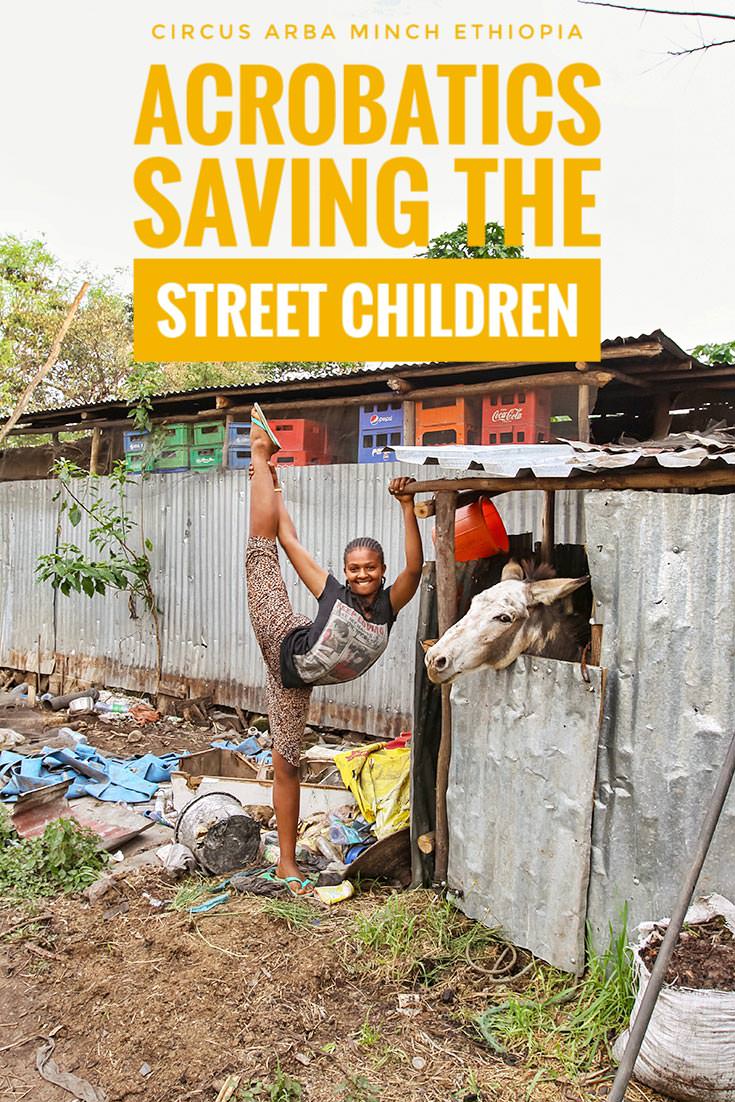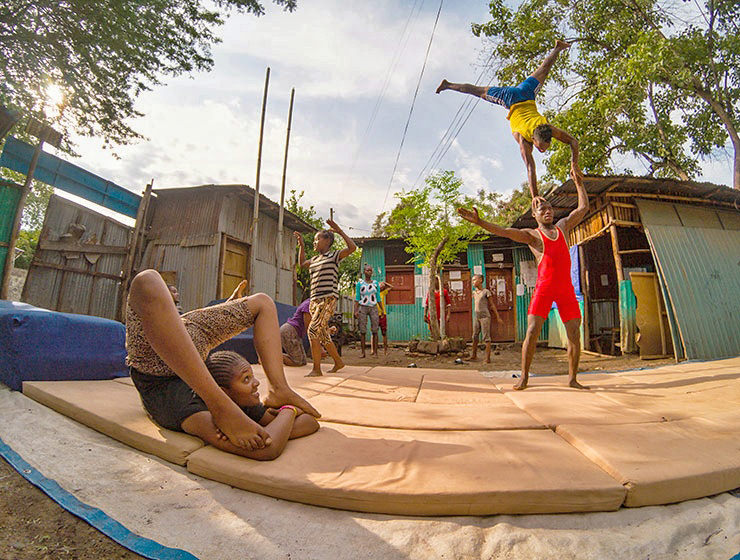Circus is everything
“I was living on the street since I was a kid”, says Sintayehu Admasu, one of the boys training in Arba Minch Circus. “My friends call me Manqo”, he adds. Manqo is not sure about when he was born, but he estimates he could be 17.
The condition to attend the circus classes is that they also attend the regular school. Education is the targetTesfahun Mergia
“Circus is everything to me because, when I was on the street, our trainer Mr. Tesfahun Mergia collected all of the street children, and brought us to Arba Minch Circus. Besides the circus training, he sent us to school, and rented a house for us to live in”, Manqo explains.
“The condition to attend the circus classes is that they also attend the regular school. Education is the target”, explains Tesfahun, rejecting the general perception of the street children as arrogant outcasts nobody can change. Indeed, they might be more aggressive when they arrive. Some leave and never come back. But the others stay and improve their behavior.
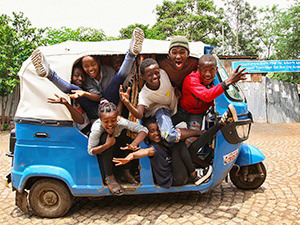
Handling costs in a creative way
Standing in the corner, Tesfahun is discretely monitoring while the kids self-organize in a practice session. Retired from the acrobat life, their young teacher leaves the stage to the new generations, both in performing and in training. He has to earn his salary in one of the NGOs; even if operating since 2011, Arba Minch Circus doesn’t have finances to employ him.
Covered by the big piece of blue fabric, circus “mats” wait for the tumbling part of the session. “When the University campus was getting rid of the old mattresses, as they were not good for students to sleep on anymore, I’ve asked the authorities if, instead of throwing them in the trash, we could use them for our training. That’s how we acquired our acrobatic mats!”, Tesfahun explains. Then he takes a wireless tennis racket in his hand, and one of the little acrobats jumps through it, elegantly like an unstoppable tennis ball.
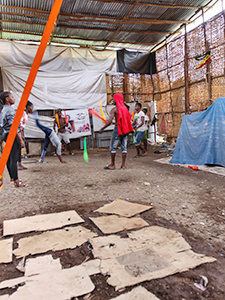
Circus building with holes
Squeezed in between the other houses in central Arba Minch, reachable only by a narrow pathway where two persons cannot go by, their training hall is a shed barely holding together. The typical Ethiopian architectural construction of the wooden poles is wrapped in the combination of fabric, tin and light wattle. The building with holes might be a natural solution for the air condition when it’s hot, but more often the holes serve as entrance points for the rain leaking in. The floor is bare earth, and in the places where it leaks the most, they laid down the cardboards to soak the water in and prevent the creation of mud.
The training is in the full mode. Girls engage in handstands, while boys juggle their colorful clubs, bringing some life into this twig-knitted building. Aerial circus training is not possible anyway. The roof holds itself, that’s already a miracle! It couldn’t support anyone else.
Training when raining
Arba Minch has an average temperature of 22 degrees Celsius, with a fair chance of precipitation about half of the year. So instead of having air-conditioning holes in the walls, the circus would find the building without the holes more useful.
“It is difficult to train in these conditions”, another 17-year-old explains. Kefeni Teshome says she wants to become the best contortionist in the world but faces a lot of challenges. “The rain makes it hard to achieve our dreams, but we don’t want to give up. We want to change our situation by performing in the hardship!”, she exclaims.
“The raining season is the worst”, Manqo confirms. “It is difficult to undertake regular training sessions in these conditions. The floor is dusty and frequently makes us suffer from flu.”
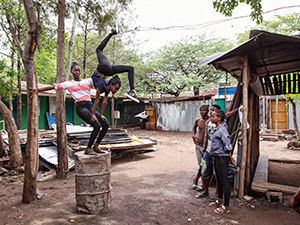
Building an acrobat from scratch
In Arba Minch Circus, the girls outnumber the boys. Even if they focus on their group circus acts divided by gender, they train together.
When things go wrong, they don’t take it too seriously. My camera adds up to the nervousness. They fall, they laugh, they get up, and do it again.
Circus doesn’t teach them just circus skills or provide afternoon fun. In the social circus environment, these kids learn about commitment, persistence, discipline and trust. With every new day in the circus, they do not become just better acrobats or jugglers. They also become better persons.
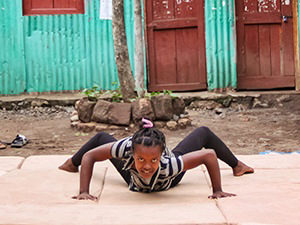
Banchayehu Hailemariam is five years old, and already following the path of her older role models: “I live on the street with my mother because we don’t have a home. My mother is begging for money in front of the church. She uses this money to buy bread for me and my younger sister. I like the circus because everyone loves me here. I have performed in different shows! When I come to the circus, my mother is very happy.”
The joy of achievement reestablishes the lost confidence in most of these kids. The process is long, and Tesfahun lets it go naturally. Nobody can change one’s life in a day. It’s a marathon.
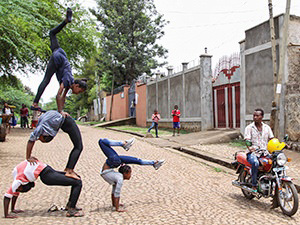
Street children in the jaws of crime, drugs and prostitution
Life in Ethiopia is hard in general. All it takes to understand this is to ride a bus into the province and look through the windows. People bathing themselves in the muddy water canals beside the road, children in ripped up trousers that expose their genitals, a look of hope when they see a white face that could ‘solve’ their problems. “Money, money!”, they call out the only English word everyone knows.
Even when one has a house, the conditions of living are quite poor. Living on Ethiopian streets doubles the risk for these children. Surrounded by crime, drugs, prostitution and other easy solutions, their childhood gets jeopardized.
On the streets of Addis Ababa, underage girls sell their bodies. The street is a dangerous place
Did you know that the prostitution in Ethiopia is legal? Child sex tourism is on the rise. On the streets of Addis Ababa, one can easily see underage girls offering their services under cover of the night.
Youngsters engage in pickpocketing as well. They do it in groups. Somebody teaches them this is the way to get the best out of their life. That this is the way to exit the circle of poverty.
On the other side, social circus groups are popping up across this vast country. There is so much need to replace bad habits with good ones. Circus has always had significant therapeutic effects in dysfunctional environments, providing the way out of the dark temptations. Children in circus find the new focus, and their spirit blooms. Engaging in a human pyramid, dance or just pure laughter with one’s peers is instantly rewarding.
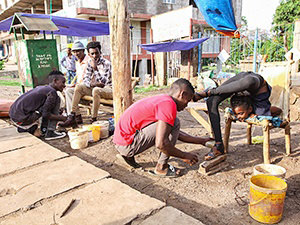
Arba Minch Circus returns to the street
Interesting enough, street performance is utterly unknown in Arba Minch. For the first time, for the purpose of my photographs, these children leave their training shed to perform in the streets of their hometown. Without the stage, without the bright costumes. Just them, and passers-by.
It is a sort of a return to where the most of them came from. The street as a challenge, now approached somewhat differently.
At first, they seem to feel awkward, but soon enough they relax and find the joy in impromptu performances on the streets of Arba Minch. There is no barrier between them and the world, no fourth wall.
Locals are surprised. An old man with a goat on a leash stops and looks in confusion. The other old man balances a huge basket on his head, while at the same time seems to be amazed by the balance achieved by these young acrobats. Whether they walk by, ride motorbikes or bajaj taxi, everyone turns head.
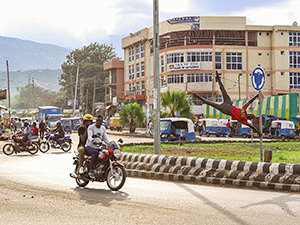
Contortion and acrobatics in everyday life
On a donkey-pulled carriage, girls present an ancient art of contortion. The street is not a place of risk anymore, but a stage. They bend like scorpions, and then – smile. It is evident that this kind of performance involves years of effort investment, yet they make it look painless. They train in shorts with leopard or tiger pattern. Their muscles bend like snakes. These kids are fearless.
I invite Apple Girma, one of the contortionists, to pose at the shoe-cleaning station, a favorite stop for the local men to get stylish bottom-up, for a few Birrs. Woman’s shoes being cleaned is already an unusual sight here, but when Apple backbends in a way that she can see her own soles if she raises (!) her head, the customer sitting at the next cleaning station stares without words. Even for the shoe cleaner, the smile comes slowly, as if not knowing how to react to such a surreal image.
Temesgen Daniel, an acrobat also known as Skanche, uses a traffic sign as a street version of the Chinese pole. He raises into a ‘human flag’ while the bajajs and motorbikes race through the crossroad. Local police do not complain.
We conquer the local football court, balance the excavator at the garbage site, climb the disposed carousel debris, enter the closets of the local furniture producer, and feed the donkey like nobody fed it before. The group seems to be enjoying seeing their hometown in the new light. Arba Minch seems to enjoy seeing their circus group in the new light.
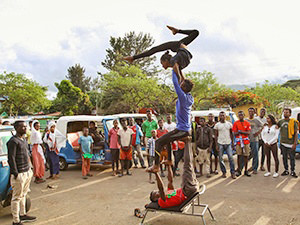
Street kids between poverty and success
On one of the impromptu performance sites, right there on the road, the traffic jam happens when a large crowd gathers to watch the pyramid of Arba Minch Circus forming. It is a circus show that cannot go unnoticed.
“Take the hat and collect the money”, I whisper to Tesfahun. He seems a bit confused. There is no tradition of busking performances in the Ethiopian streets.
Instead, at the end of the acrobatic feat, one of the boys from the audience comes to me, a white foreigner, and reverses it completely. Pulling my sleeve, he demands: “Money, money!”
“Look, Tesfahun, here’s your next acrobat!”, I joke.
Tesfahun answers that indeed this particular little street beggar, tall just enough to reach my pocket, is already training circus in his group! He is somewhere in between. Leaving the street is not easy and, as we said, changing life habits doesn’t happen in one day. It’s a marathon.
In Arba Minch, a circus tribe is being built slowly. Maybe less exotic than the ones from the Omo Valley, perhaps under the radar of the visitors looking to discover the best attractions of Ethiopia. But at the same time, Arba Minch Circus is proving how dedication can construct amazing opportunities. Changing and improving the lives of children is radically changing the prospects for the whole community. The vision is there. There is a whole new life waiting down the road.
Pipeaway engaged in the project Circus of Postcards, that aims to support better conditions for the training of the street kids in the African social circuses. Learn how you can help this project of building better perspectives for the Ethiopian street children!
Did you like this article?
Pin it for later!
